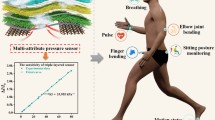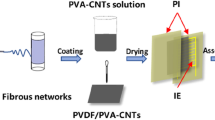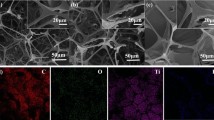Abstract
In this paper, a new method was proposed to improve the sensitivity of capacitive-type pressure sensors by using the high dielectric constant materials as dielectric layer of sensors. The porous multi-wall carbon nanotubes (MWCNTs)/Ecoflex elastomer composites with high dielectric constant were prepared to serve as dielectric layers of capacitive-type pressure sensors. The MWCNTs/Ecoflex elastomer composite sensors show ultra-high sensitivity of 2.306 kPa−1, wide dynamic range and low hysteresis. The as-prepared sensors can monitor the response to pressure below 2.6 Pa. Moreover, they have exhibited excellent performances in promising practical applications as wearable devices in detecting pulses of carotid artery and heartbeats. This strategy proposed here presents a promising way to obtain high performance pressure sensors for applications in E-skin, robotics, wearable medical aids and real-time tactile sensing systems.
Similar content being viewed by others
Explore related subjects
Discover the latest articles, news and stories from top researchers in related subjects.Avoid common mistakes on your manuscript.
1 Introduction
In recent years, flexible pressure sensors have been attracting attentions due to their widely advanced applications in flexible electronic skin [1, 2], mobile medical aids [3,4,5], energy collection [3, 6, 7], flexible touch screen [8, 9], artificial limb [10] and so on. These applications relate to human tactile pressure interactions between the users and the devices. So flexible pressure sensors are required to possess a high sensitivity in the low pressure range which can detect blood pressure or mild touches (0–10 kPa), and a wide pressure-measurement range which can cover the entire tactile pressure range (0–100 kPa) [11, 12].
Recently, the reported studies have focused on the improvement of the sensor sensitivity in the low-pressure range, involving three main mechanisms, capacitance [11, 13, 14], piezoresistivity [15], and piezoelectricity [16], which can convert physical variables (pressure, and strain, etc.) into electrical signals. Specifically, a number of porous structured materials were employed to enhance the sensitivity of sensors, due to their high deformation of porous structures under even small amounts of pressure, such as, polydimethylsiloxane (PDMS) sponges [17], micropatterned PDMS electrodes/PS microsphere layer [18], RGO/PU (or PVC) sponges [19], PANI/sponge composites [20], PDMS porous network structure with graphene [21], porous carbon nanotube-thermoplastic polyurethane [22], and porous carbon/PDMS composites [23], etc. For capacitive-type pressure sensors, the porous structured dielectric materials are incorporated within a parallel-plate capacitor. The high deformability of porous structures can increase the sensitivity of sensors. In addition, an important advantage is that air in micropores is squeezed out of porous layer under compression. The decrease of air in porous layer can lead to an increase of the effective dielectric constant of porous layer, thereby further enhancing the sensitivity [17, 20, 24]. This increase of the effective dielectric constant can be improved by improving the dielectric constant of porous dielectric materials. Consequently, a new strategy to improve the sensitivity of capacitive-type pressure sensors can be proposed by using the higher dielectric constant materials as dielectric layer of capacitive-type pressure sensors.
Currently, the polymer elastomers, PDMS and Ecoflex, are widely used as porous dielectric layers in capacitive-type pressure sensors because of their advantages, such as high elasticity, high dielectric constant, and good recovery property. Their composites with the multiwalled carbon nanotubes (MWCNTs) have a higher dielectric constant [25, 26]. For example, the dielectric constant of poly(vinylidene fluoride) (PVDF) can be increased up to 3600 at 1 kHz by composite of MWCNTs [26].
Following this line of thought, we propose a new method for improving the sensitivity of capacitive-type sensors by using the higher dielectric constant materials as dielectric layer. The Ecoflex elastomers were used as the polymer matrix owing to its low elastic modulus and high dielectric constant (εr = 3.2–3.5), compared to PDMS (εr = 2.5‒2.8). The porous MWCNTs/Ecoflex composite dielectric layer was prepared by molding Ecoflex within the template of mixtures of salt particles and MWCNTs. The top and bottom electrodes coupled with porous MWCNTs/Ecoflex composite dielectric layer constructed the device. The capacitive-type pressure sensors showed an ultra-high sensitivity, up to 2.309 kPa−1, which is 4.2 times the value of sensor of the pure Ecoflex. Furthermore, the pressure sensors exhibited low detection limit (~ 2.6 Pa), wide pressure-measurement range (0–100 kPa), and low hysteresis. This strategy proposed here demonstrates a promising way to obtain high performance pressure sensors, covering the entire tactile pressure range.
2 Experimental details
The preparation process of sensors was presented schematically in Fig. 1a.
a Schematic diagram of the flexible MWCNTs/Ecoflex film electrodes (top and bottom) and the porous dielectric layer (middle); b photographs of the porous MWCNTs/Ecoflex composite layer under relaxing (left) and compressing (right) conditions; c photographs of the porous structure layer of pure Ecoflex under relaxing (left) and compressing (right) conditions; d schematic diagram of a capacitive-type pressure sensor using the porous structures; e a photograph of the as-prepared sensor using the porous MWCNTs/Ecoflex composite layer
The Ecoflex (Ecoflex Shore hardness, 00−30; Smooth-On, Inc., Macungie, PA, USA) prepolymer solution was prepared by mixing a base and a cured agent at a weight ratio of 1:1. MWCNTs (purity > 95 wt%, diameter 8 – 15 nm, length about 50 µm, Aladdin) dispersed in isopropyl alcohol (1 wt%) were spray-coated onto a high gloss paper with a coating mask. After drying and removing the mask, a prepolymer solution of Ecoflex was poured onto the high gloss paper with the MWCNTs patterns, and degassed in the vacuum chamber. The Ecoflex film with the MWCNTs patterns peeled from the high gloss paper was served as the electrode after curing in drying oven at 60 °C for 1 h, as shown schematically in the top and the bottom of Fig. 1a.
A porous dielectric layer was formed by molding Ecoflex within a cube template [24]. The mixtures of salt particles (diameter about 250–300 µm) and MWCNTs were extruded into a cube as a template with the various MWCNTs content. The templates were immersed in the prepolymer of Ecoflex and degassed in a vacuum chamber for 2 h. After curing in a drying oven at 60 °C for 1 h, the samples were dipped into deionized water to completely dissolve the salt and the porous MWCNTs/Ecoflex composites were formed shown schematically in the middle of Fig. 1a. Figure 1b, c show photographs of the porous MWCNTs/Ecoflex composite layer and the porous Ecoflex layer under relaxing and compressing conditions. The as-prepared porous layers have high extremely compressibility. The MWCNTs content of the porous layers were calculated as 0 wt%, 0.3 wt%, 0.65 wt%, and 1 wt% respectively. Consequently, the flexible sensors were fabricated by incorporating porous MWCNTs/Ecoflex composite between two MWCNTs/Ecoflex film electrodes, as shown schematically in Fig. 1d. A photograph of the as-prepared sensor of porous MWCNTs/Ecoflex composites was displayed in Fig. 1e.
The morphology of the samples was characterized by field emission scanning electron microscopy (FESEM, JSM-6700F, JEOL, JP). The Raman spectra were performed by Raman spectroscopy (InViaReflex, Renishaw, UK) using a 532 nm laser as the exciting source. The dielectric properties of the as-prepared porous layers were measured using impedance analyzer (E4990A, Keysight, USA) at 300 kHz. A force gauge (DPS-50N, Yinuo, TW) was used to measure the applied force. The capacitance of flexible sensors was measured using a precision LCR meter (TH2818, Tonghui, China) under the signal of 1 V at 300 kHz. Note that the electrical measurements were performed under ambient conditions.
3 Results and discussions
Figure 2 shows the SEM images of the as-prepared porous layers. As shown Fig. 2a–c, the porous structures were formed in the samples containing 0 wt%, 0.3 wt% and 0.65 wt% MWCNTs respectively, with about 250–300 µm of the pore diameter. For the sample with 1 wt% MWCNTs, the framework of porous structures has collapsed, as presented in Fig. 2d. But this sample can keep cubic shape still.
The Raman spectra of four samples were shown in Fig. 3. The composite samples and the pure MWCNTs exhibit two peaks near 1343 cm−1 and 1580 cm−1, corresponding to the characteristics bands of D and G of MWCNTs respectively, which indicates that MWCNTs are hybridized with Ecoflex successfully.
Figure 4a displays the curves of the external applied pressure (P) versus the responses \(({\text{C}} - {{\text{C}}_0})/{{\text{C}}_0},\) where C and C0 represent the capacitance under compression and initial capacitance of the different samples in the pressure range of 0‒100 kPa. The MWCNTs/Ecoflex composite sensors show higher response, compared to the pure Ecoflex sample, and the response increases with the MWCNTs content of samples. The response of the sample with 1 wt% MWCNTs is about 14.81 at 100 kPa, about 7.4 times of the pure Ecoflex sample (1.99 at 100 kPa). In the low-pressure range (below 60 Pa), the response of the different samples for an increasing pressure (P) were measured. The curves and their corresponding linearly fitted lines were shown in Fig. 4b. The sensitivity (S) of sensor is defined as the slope of the curve \(({\text{S}}=\Delta (({\text{C}} - {{\text{C}}_0})/{{\text{C}}_0})/\Delta {\text{P}}).\) Form Fig. 4b, the pressure-sensing performances of all samples exhibit linear behavior (R2 ≥ 0.991) in the low-pressure range and the corresponding sensitivities of four samples are 0.547 kPa−1 (0 wt%), 1.367 kPa−1 (0.3 wt%), 1.937 kPa−1 (0.65 wt%), and 2.306 kPa−1 (1 wt%) respectively. It should be noted that the sensitivity of samples increase with the MWCNTs content. The sensitivity of the MWCNTs/Ecoflex composite sensors with 1 wt% MWCNTs is highest, 2.306 kPa−1, about 4.2 times that of the pure Ecoflex. This ultra-high sensitivity can be attributed to the higher dielectric constant of the MWCNTs/Ecoflex composites compared with the pure Ecoflex. Figure 4c shows the dielectric constant of the porous layers as a function of MWCNTs content at 300 kHz. The dielectric constant of samples increases with MWCNTs content. Typically, the dielectric constant of the MWCNTs/Ecoflex composites with 1 wt% MWCNTs is 9.390, which is about 4.4 times that (2.104) of the pure Ecoflex, in agreement with the increment of sensitivity of this sample nearly. These results demonstrate that the proposed method in our case is a promising way to improve the sensitivity of pressure sensor.
a Pressure–response curves of four pressure sensors with 0 wt%, 0.3 wt%, 0.65 wt%, and 1 wt% MWCNTs respectively in the range of 0–100 kPa; b pressure–response curves of four pressure sensors and their corresponding fitted lines in the low-pressure range (below 66 Pa); c dielectric constant of four porous dielectric layer as a function of MWCNTs content; d transient responses of three composite pressure sensors with 0.3 wt%, 0.65 wt%, and 1 wt% MWCNTs to 40 mg object respectively; e stability studies of four pressure sensors over 50 repeated compression-release cycles at 0 and 20 kPa, f hysteresis properties of four prepared sensors
Further, the limit of detection, an important parameter for detection of ultralow-pressure, was examined by loading about 40 mg object on the prepared sensors, which corresponds to a pressure of about 2.6 Pa. As shown in Fig. 4d, three MWCNTs/Ecoflex composite samples show a distinguishable response. The response of the sample with 1 wt% MWCNTs is highest among the three composite samples.
To evaluate stability of the prepared sensors, the response of the prepared sensors was tested repeatedly over 50 compression/release cycles between a minimum pressure of 0 kPa and a maximum pressure of 20 kPa, as shown in Fig. 4e. It can be seen that there is no obvious change in variations of capacitance, indicating that all the prepared sensors exhibited good stability. Besides, in order to evaluate hysteresis properties of sensors, the responses of four samples containing 0 wt%, 0.3 wt%, 0.65 wt%, and 1 wt% MWCNTs were detected during a continuous compressing and releasing cycle from 0 to 100 kPa. The results were shown in Fig. 4f. The pure Ecoflex sensor shows the largest hysteresis, and other three composite sensors show negligible hysteresis. The addition of MWCNTs to Ecoflex leads to a decrease of hysteresis, which could be because the high elastic modulus of MWCNTs enables them to increase the elastic modulus of the composite elastomer [27,28,29]. Our results indicate that the composite sensors have good reversible compression/release behavior at various pressure levels.
Table 1 shows the comparison of performances with other reported works constructed with various porous elastomers. By contrast, our MWCNTs/Ecoflex composite sensors exhibit ultra-high sensitivity in low pressure range. Specifically, the sensitivity of the MWCNTs/Ecoflex composite sensors with 1 wt% MWCNTs, about 2.306 kPa−1, is higher than that from other previous studies [1,2,3,4,5,6,7, 9].
4 Application
To investigate their practical applications as wearable pressure devices, three MWCNTs/Ecoflex composite sensors were employed to monitor the pulses of carotid artery and the heartbeats of a human by fixing the sensors at the neck and the chest respectively, as illustrated schematically in Fig. 5a. The monitoring results of pulses were in Fig. 5b. All three sensors can detect the pulses clearly in real-time, and the results are similar, about 78 beats/min. Form Fig. 5c, the heartbeats can be detected clearly by our three composite sensors in real-time too, which exhibited about 78 beats/min. The pulse rate counted by the three sensors is coincident with the heart rate obtained, demonstrating that the sensor signals come from the pulse and the heartbeat truly. Therefore, our prepared sensors can be expected to apply in human–machine interface system, and mobile medical aids.
5 Conclusions
In summary, we have reported a new method to improve the sensitivity of capacitive-type pressure sensors. The porous MWCNTs/Ecoflex elastomer composites was designed and prepared through a simple route for application in capacitive-type pressure sensors, which have higher dielectric constant than the pure Ecoflex elastomer. The MWCNTs/Ecoflex elastomer composite sensors show ultra-high sensitivity, wide dynamic range and low hysteresis. Moreover, they exhibited promising practical applications as wearable devices in detecting the pulses of carotid artery and the heartbeats. It can be anticipated that the MWCNTs/Ecoflex elastomer composite sensors could be applied in E-skin, robotics, wearable medical aids and real-time tactile sensing systems, etc.
References
X. Wang, L. Dong, H. Zhang, R. Yu, C. Pan, Z.L. Wang, Adv. Sci. 2, 1500169 (2015)
B.C. Tee, A. Chortos, A. Berndt, A.K. Nguyen, A. Tom, A. Mcguire, Z.C. Lin, K. Tien, W.G. Bae, H. Wang, Science 350, 313–316 (2015)
Y. Khan, A.E. Ostfeld, C.M. Lochner, A. Pierre, A.C. Arias, Adv. Mater. 28, 4373–4395 (2016)
H.Y. Nyein, W. Gao, Z. Shahpar, S. Emaminejad, S. Challa, K. Chen, H.M. Fahad, L.C. Tai, H. Ota, R.W. Davis, A. Javey, ACS Nano 10, 7216–7224 (2016)
T.Q. Trung, N.E. Lee, Adv. Mater. 28, 4338–4372 (2016)
C. Dagdeviren, P. Joe, O.L. Tuzman, K.I. Park, K.J. Lee., Y. Shi, Y. Huang, J.A. Rogers, Extreme Mech. Lett. 9, 269–281 (2016)
S. Park, H. Kim, M. Vosgueritchian, S. Cheon, H. Kim, J.H. Koo, T.R. Kim, S. Lee, G. Schwartz, H. Chang, Adv. Mater. 26, 7324–7332 (2014)
F.R. Fan, L. Lin, G. Zhu, W. Wu, R. Zhang, Z.L. Wang, Nano Lett. 12, 3109–3114 (2012)
D.J. Lipomi, M. Vosgueritchian, B.C. Tee, S.L. Hellstrom, J.A. Lee, C.H. Fox, Z. Bao, Nat. Nanotechnol. 6, 788–792 (2011)
C. Chen, X. Wu, D.X. Liu, W. Feng, C. Wang, Mob. Inf. Syst. (2017). https://doi.org/10.1155/2017/8682168
S.C. Mannsfeld, B.C. Tee, R.M. Stoltenberg, C.V. Chen, S. Barman, B.V. Muir, A.N. Sokolov, C. Reese, Z. Bao, Nat. Mater. 9, 859–864 (2010)
Y. Zang, F. Zhang, C.A. Di, D. Zhu, Mater. Horiz. 2, 140–156 (2015)
N. Shao, J. Wu, X. Yang, J. Yao, Y. Shi, Z. Zhou, Micro Nano Lett. 12, 45–48 (2017)
S. Wan, H. Bi, Y. Zhou, X. Xie, S. Su, K. Yin, L. Sun, Carbon 114, 209–216 (2017)
S. Gong, W. Schwalb, Y. Wang, Y. Chen, Y. Tang, J. Si, B. Shirinzadeh, W. Cheng, Nat. Commun. 5, 3132 (2014)
C. Dagdeviren, Y. Su, P. Joe, R. Yona, Y. Liu, Y.S. Kim, Y. Huang, A.R. Damadoran, J. Xia, L.W. Martin, Y. Huang, J.A. Rogers, Nat. Commun. 5, 4496 (2014)
B.Y. Lee, J. Kim, H. Kim, C. Kim, S.D. Lee, Sens. Actuators A 240, 103–109 (2016)
T. Li, H. Luo, L. Qin, X. Wang, Z. Xiong, H. Ding, Y. Gu, Z. Liu, T. Zhang, Small 12, 5042–5048 (2016)
B.X. Zhang, Z.L. Hou, W. Yan, Q.L. Zhao, K.T. Zhan, Carbon 125, 199–206 (2017)
X.X. He, J.T. Li, X.S. Jia, L. Tong, X.X. Wang, J. Zhang, J. Zheng, X. Ning, Y.Z. Long, Nanoscale Res. Lett. 12, 476 (2017)
Y. Pang, H. Tian, L. Tao, Y. Li, X. Wang, N. Deng, Y. Yang, T.L. Ren, ACS Appl. Mater. Interfaces 8, 26458–26462 (2016)
H. Liu, W. Huang, J. Gao, K. Dai, G. Zheng, C. Liu, C. Shen, X. Yan, J. Guo, Z. Guo, Appl. Phys. Lett. 108, 011904 (2016)
X.H. Zhao, S.N. Ma, H. Long, H. Yuan, C.Y. Tsang, P.K. Cheng, Y.H. Tang, ACS Appl. Mater. Interfaces 10, 3986–3993 (2018)
D. Kwon, T.I. Lee, J. Shim, S. Ryu, M.S. Kim, S. Kim, T.S. Kim, I. Park, ACS Appl. Mater. Interfaces 8, 16922–16931 (2016)
C. Huang, Q.M. Zhang, Adv. Mater. 17, 1153–1158 (2005)
Q. Li, Q. Xue, Q. Zheng, L. Hao, X. Gao, Mater. Lett. 62, 4229–4231 (2008)
L. Bokobza, Polymer 48, 4907–4920 (2007)
J.B. Lee, D.Y. Khang, Compos. Sci. Technol. 72, 1257–1263 (2012)
Z. Ounaies, Compos. Sci. Technol. 63, 1637–1646 (2003)
L. Viry, A. Levi, M. Totaro, A. Mondini, V. Mattoli, B. Mazzolai, L. Beccai, Adv. Mater. 26, 2659–2664 (2014)
L.X. Mo, Y.Q. Hou, Q.B. Zhai, W.G. Zhang, L.H. Li, Appl. Mech. Mater. 748, 1–4 (2015)
Acknowledgements
This work was financially supported by the National Natural Science Foundation of China (Grant Nos. 11054331, 61605174, 11774318 and 11604302), and Scientific Research Program Funded by Henan Provincial Education Department (Grant No. 15A140040).
Author information
Authors and Affiliations
Corresponding author
Rights and permissions
About this article
Cite this article
Wen, Z., Yang, J., Ding, H. et al. Ultra-highly sensitive, low hysteretic and flexible pressure sensor based on porous MWCNTs/Ecoflex elastomer composites. J Mater Sci: Mater Electron 29, 20978–20983 (2018). https://doi.org/10.1007/s10854-018-0242-3
Received:
Accepted:
Published:
Issue Date:
DOI: https://doi.org/10.1007/s10854-018-0242-3









